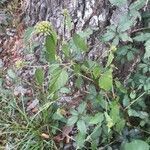Herbs or subshrubs, less than 1 m tall, erect or decumbent. Branches yellow-brown, sparsely stellate puberulent. Stipules linear, 2-4 mm; petiole 5-25 mm; leaf blade ovate, oblong-ovate, or lanceolate, rarely obscurely 3-lobed, 2.5-7 × 1-1.3 cm, thinly papery, abaxially sparsely stellate puberulent, adaxially nearly glabrous, basal veins 5, base rounded or cordate, margin dentate, apex acute or obtuse. Inflorescence a dense cyme or glomerule, terminal or axillary. Epicalyx lobes 4, linear, hairy. Calyx campanulate, 5-lobed, ca. 2.5 mm, abaxially villous and hispid, adaxially glabrous, lobes triangular. Petals 5, white, drying reddish, oblong, ca. 6 mm, narrowed at base. Stamens 5, connate at base, opposite petals. Ovary sessile, densely velutinous; styles 5, filiform. Capsule globose, 5-angular, 5-6 mm in diam., villous. Seeds 1 or 2 per cell, brown-black, ovoid, slightly triangular, 2-3 mm. Fl. summer-autumn.
A herb or small shrub that can re-grow each year or continue growing for a few years. It grows 0.2-1.5 m high and spreads 0.5-1.5 m wide. It has a somewhat woody rootstock. The lower stem is hollow. The young growth can be slightly hairy. The branches can be spreading or erect. The leaves are 2-6 cm long by 1-3 cm wide. They are sword shaped or oval. Sometimes the leaves have 3 lobes. The edge of the leaf has small teeth. The tip of the leaf is pointed. The flowers are 1 cm across. They occur in short clusters and are purple. They are near the ends of branches. The petals are about 0.5 cm long. The fruit is a capsule about 0.5 cm across. It is round and usually slightly hairy.
Herbs, annual or perennial, or subshrubs, to 2 m, taprooted. Leaves: petiole 0.3–5.5 cm; blade ovate to lanceolate, 1.3–9 × 1–7 cm, glabrate, hairs simple on veins. Inflorescences terminal, cymose glomerules, 10–25-flowered; bracteoles 3 or 4, immediately subtending flower. Flowers monomorphic; calyx 2–2.5 mm, teeth acute, distant and sinuses between them rounded; petals purple, pink, or white with yellow base, 3–6 × 1–1.5 mm; stamens and pistil equal, 2.5–3.2 mm. Fruits schizocarps, white, pink, green, purplish, or black, subglobose, not winged, not beaked, 4–5 × 5–6 mm, dehiscence loculicidal and then septicidal, fruit falling apart. Seeds 1 per locule. 2n = 36, 46.
Leaf-lamina up to c. 7 × 4·5 cm., oblong-lanceolate, narrowly ovate or ovate, apex acute, margin acutely serrate, base broadly cuneate or truncate and 5-nerved, thinly hispidulous at least on the nerves below; petiole up to 2·3 cm. long, pubescent at least on the upper surface; stipules c. 1 cm. long, subulate-lanceolate, margins ciliolate.
Stamens adherent to the petals below; filaments united in a tube almost to the apex, about 1/2 the length of the petals, free portion of filaments c. 1 mm. long; pairs of anther-thecae connate in the lower half, free above.
Flowers numerous, in dense terminal or axillary cymes; peduncle up to 5 cm. long; pedicels 1–3 mm. long, hispidulous; bracts 4–10 mm. long, numerous, subulate-lanceolate, ciliolate at the margins.
Erect annual herb up to c. 2 m. tall but often less; stems glabrescent but with a line of stellate hairs decurrent from the stipule bases.
Capsule 5 mm. in diam., subglobose, hispidulous, 5-valved, surrounded by the persistent calyx and bracts.
Ovary oblong-ovoid, densely pilose; styles 5, slightly connate below, c. 2 mm. long, hirsute.
Seeds c. 3 × 2·5 mm., 1 per loculus, dark brown or greyish, 3-sided; testa minutely striate.
Calyx 3 mm. long, campanulate, with very short abruptly acuminate teeth, ciliolate.
Petals white, yellow at the base inside, c. 8 mm., obovate.
Flowers small, white or sometimes yellowish or pinkish
Hollow stems, erect or sometimes prostrate
Herb or undershrub,-11/2–2 ft. or more







